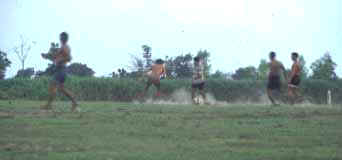As I said on the first page my method has been suggestive rather than explanatory and explicit. I have tried to present a range of information from the day to day life to broader historical concerns to the brief outline of the life history of José Maria. The point then is to open the material and to engage people to investigate more deeply. This also means the material can be used for a variety of purposes.
First Picture: The sunset at the narrowest point of the Amazon River
The following are topics that are relevant to this case study
1. The Nature of the Amazonian Peasantry: In what way are peasants living in riverine area different and similar from other types of Latin American peasantries e.g. Andean, North-Eastern Brazilian and Mexican ones for example? Stephen Nugent's book Amazon Caboclo Society is particularly strong on this issue. You can also look at David Cleary's article in the Journal of Latin American Studies (1993).
Why is this question important? For me it is crucial because it concerns the identity and the ethnohistory of Amazonian people. Without an understanding of these factors, it is impossible to accord them their proper place in the history. They would otherwise remain invisible or pawns in the development of Brazil.
What do you think are the similarities between these Amazonian peasants and the ones in John Gledhill's case study?
Do you think there can be a typology of Latin American peasantries?
2. How can we deal with their own contemporary expressions of identity? Here I think Candace Slater's book The Dance of the Dolphin is very useful. She claims the stories of the dolphin represent a body of symbolic forms resisting and a commentary on the changes taking place in the Amazon. This has important implications too for a reevaluation of their alleged marginal status. In what sense are they marginal, to what and to whom? You could look at two articles in the edited volume, Lilies of the Field (Ed. S. Day, M. Stewart, A. Papataxiarchis, Westview Press). The first article is by Mark Harris (the author of the present study) and the second by Stephen Nugent who examine some of these issues.
Second Picture: A football match on the floodplain
3. Economic and ecological anthropology. Following work by Stephen Gudeman my work takes up the challenge of combining an economic and ecological anthropology. My analytical argument is organised around two connected sets of relationships which constitute contemporary peasant livelihoods. The first concerns their historical experience of accommodating external demands and creating an identity for the new population beginning in the early colonial modernity of the New World. The second is the material organisation of daily lives in a specific environment. Through detailed attention to the historical dynamism and current economic and kinship strategies of the floodplain peasantry in the Lower Amazon, this study examines how they have been able to provide continuity for their way of life, and most of all their claims and rights to land occupation. The idiom for this identity are their relations with the environment and especialy the dramatic seasonal nature of their lives. The continual observation of environmental changes and execution of necessary economic adjustments have made them attuned to shifts in market demands. Their resilience offers a potent model for sustainably developing the Amazon floodplain in the face of rapid transformation of the physical and social landscape.
In what way can we analyse the influence of the environment on the social and economic organisation of the people on the floodplain?